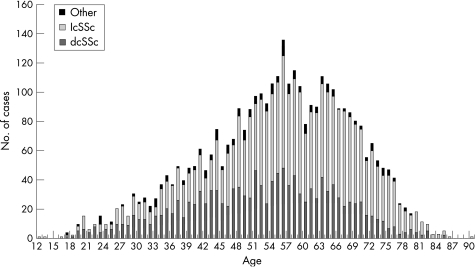BACKGROUNDSystemic sclerosis (SSc) is a multisystem autoimmune illness, which is assessed into a diffuse cutaneous (dcSSc) and a restricted cutaneous (lcSSc) subset based on the pores and skin involvement.
In order to higher perceive the vascular, immunological and fibrotic processes of SSc and to information its therapy, the EULAR Scleroderma Trials And Research (EUSTAR) group was shaped in June 2004.OBJECTIVEEUSTAR collects prospectively the Minimal Essential Data Set (MEDS) on all sequential sufferers fulfilling the American College of Rheumatology diagnostic standards in collaborating centres.
We aimed to characterise demographic, medical and laboratory traits of illness presentation in SSc and analysed EUSTAR baseline visits.RESULTSIn April 2006, a whole of 3656 sufferers (1349 with dcSSc and 2101 with lcSSc) had been enrolled in 102 centres and 30 nations. 1330 people had autoantibodies towards Scl70 and 1106 towards anticentromere antibodies.
87% of sufferers had been ladies. On multivariate evaluation, scleroderma subsets (dcSSc vs lcSSc), antibody standing and age at onset of Raynaud’s phenomenon, however not gender, had been discovered to be independently related to the prevalence of organ manifestations.
Autoantibody standing in this evaluation was extra carefully related to medical manifestations than had been SSc subsets.CONCLUSIONSdcSSc and lcSSc subsets are related to explicit organ manifestations, however in this evaluation the medical distinction appeared to be outdated by an antibody-based classification in predicting some scleroderma problems.
The EUSTAR MEDS database facilitates the evaluation of medical patterns in SSc, and contributes to the standardised assessment and monitoring of SSc internationally.

Discordance of databases designed for claims cost versus medical data programs. Implications for outcomes analysis.
OBJECTIVETo decide the suitability of insurance coverage claims data to be used in medical outcomes analysis in ischemic coronary heart illness.METHODSConcordance research of two databases.METHODSTertiary care referral middle.METHODSA whole of 12,937 consecutive sufferers hospitalized for cardiac catheterization for suspected ischemic coronary heart illness between July 1985 and May 1990.
METHODSTwo-by-two tables had been used to compute general and kappa measures of settlement evaluating medical versus claims information for 12 essential predictors of prognosis in sufferers with ischemic coronary heart illness.
METHODSKappa statistics (settlement adjusted for probability settlement) had been used to quantify settlement charges.RESULTSAgreement charges between the medical and claims databases ranged from 0.83 for the prognosis of diabetes to 0.09 for the prognosis of unstable angina (kappa values).
Claims information didn’t establish a couple of half of the sufferers with prognostically essential circumstances, together with mitral insufficiency, congestive coronary heart failure, peripheral vascular illness, outdated myocardial infarction, hyperlipidemia, cerebrovascular illness, tobacco use, angina, and unstable angina, in comparison with the medical data system.
CONCLUSIONSOur outcomes recommend that insurance coverage claims information lack essential diagnostic and prognostic data in comparison with concurrently collected medical information in the research of ischemic coronary heart illness.
Thus, insurance coverage claims information are usually not as helpful as medical information for figuring out clinically related affected person teams and for adjusting for risk in end result research, comparable to analyses of hospital mortality.
